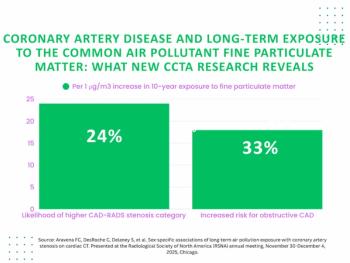Emerging research reveals significantly higher accuracy for photon-counting detector computed tomography (PCD-CT) in detecting obstructive coronary artery disease (CAD) in contrast to energy-integrating CT (EID-CT) and may facilitate a nearly 15 percent reduction of referrals for invasive coronary angiography (ICA) procedures.
For the prospective multicenter study, recently published in European Radiology, researchers compared the use of PCD-CT and EID-CT for detecting CAD in 252 patients with stable chest pain and > 50 percent stenosis undergoing invasive coronary angiography (ICA). The PCD-CT cohort was comprised of 143 patients (average age of 66) with a total of 572 evaluated vessels and 2,431 segments, and the EID-CT group (average age of 65) had 109 patients with a total of 436 assessed vessels and 1,853 segments, according to the study.
For patients with > 50 percent stenosis, the study authors found that PCD-CT offered 10.2 percent, 13.8 percent and 5.3 percent higher accuracy than EID-CT at the patient level, vessel level and segment level respectively.
Photon-counting CT also demonstrated over 20 percent higher accuracy than EID-CT for detecting stenosis > 70 percent (90.9 percent vs. 70.6 percent) at the patient level, according to the researchers. In this patient population, the study authors also noted 13.7 percent higher accuracy at the vessel level (94.6 percent vs. 80.9 percent) and 4.5 percent higher accuracy at the segment level (98.6 percent vs. 94.1 percent).
“The results showed that PCD-CT demonstrated excellent vessel- and segment-based performance for stable angina patients referred for CCTA and yielded significantly higher patient-level accuracy than EID-CT.,” wrote lead study author Melissa Boussoussou, M.D., Ph.D., who is affiliated with the Semmelweis University Heart and Vascular Center in Budapest, Hungary, and colleagues.
The study authors also utilized a Monte Carlo simulation model and the diagnostic accuracy assessments of PCD-CT and EID-CT in a cohort of patients with CAD-RADS 3 or CAD-RADS 4 in order to assess potential differences in referrals for ICA procedures. In this model, patients with > CAD-RADS 4 were eligible for direct ICA referral whereas those with CAD-RADS 3 only had ICA if there were positive results with function testing.
Three Key Takeaways
- PCD-CT markedly improves diagnostic accuracy for obstructive CAD. It outperformed EID-CT by 13.7 percent at the patient, by 4.5 percent at the vessel level and by >20 percent at the patient level for detecting >70% stenosis.
- Higher accuracy with PCD-CT can reduce unnecessary invasive angiography. Simulation modeling projected a nearly 15 percent decrease in ICA referrals compared to EID-CT.
- PCD-CT supports more efficient care pathways in stable chest pain. Strong vessel- and segment-level performance suggests potential for safer, streamlined evaluation, though broader validation and guidance on ultra-high-resolution (UHR) protocols are needed.
Out of 30,000 iterations of the simulation model, the researchers noted a 14.8 percent reduction in ICA referrals for PCD-CT in contrast to EID-CT (821.7 vs. 964.3).
“By lowering the reliance on ICA, the associated risks and potential complications are also diminished, contributing to improved patient safety. Additionally, this shift in practice alleviates the workload on healthcare providers and reduces resource strain, resulting in more efficient management of patient care and easing the overall burden on health-care systems,” added Boussoussou and colleagues.
(Editor’s note: For related content, see “Why Plaque Burden is Critical to Assessing Cardiovascular Risk: An Interview with Ibrahim Danad, MD, PhD,” “Emerging Advances in Photon-Counting Computed Tomography” and “Photon-Counting CT Study Examines Impact of Scan Mode on Radiation Dosing for CCTA in Patients with Non-Acute Chest Pain.”)
In regard to study limitations, the authors acknowledged a relatively small sample size for a multicenter cohort, a lack of guideline insight on the use of ultra-high resolution for PCD-CT and a lack of quantitative analysis for ICA.





























